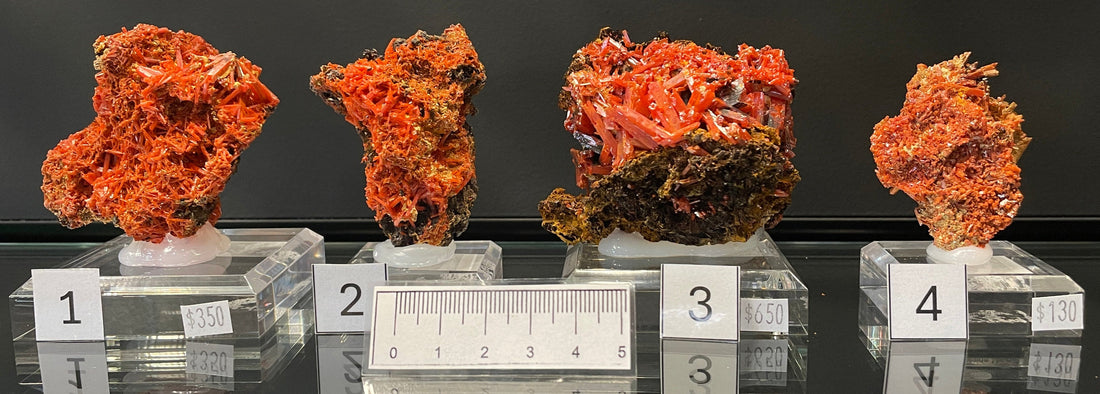
Crocoite: Mineral Profile and Significance
Share
Crocoite is a monoclinic mineral composed of lead chromate (PbCrO₄). It is classified within the chromate group and is notable for its striking colouration, ranging from bright orange to deep red. The mineral typically forms slender, prismatic crystals with an adamantine to vitreous lustre and a Mohs hardness of 2.5 to 3. Its specific gravity ranges from 5.9 to 6.1, reflecting its lead-rich composition.
Crocoite is highly sought after by collectors due to its intense colour, crystal habit, and rarity. It is also the mineral from which chromium was first isolated in the late 18th century, marking its historical importance in the development of inorganic chemistry.
Geological Context: Adelaide Mine, Tasmania
The Adelaide Mine, located near Dundas in western Tasmania, is globally recognised for producing the finest crocoite specimens. The mineral occurs in oxidised zones of lead ore deposits, where hydrothermal fluids have introduced chromium into galena-bearing veins. The unique geological setting of the Zeehan district, with Cambrian serpentinite intrusions and Devonian granitic activity, created ideal conditions for crocoite formation.
The mine has yielded crocoite crystals of exceptional size and quality, often found in hollow cavities within the host rock. These specimens are typically associated with other secondary lead minerals such as cerussite, gibbsite, and pyromorphite.
Mining History and Frank Mahalovich’s Contribution
During the 1990s, Frank Mahalovich played a pivotal role in the extraction and distribution of crocoite from the Adelaide Mine. His work involved careful underground recovery of delicate crystal specimens, which were then prepared and sold to collectors and institutions worldwide. Mahalovich’s efforts helped establish the Adelaide Mine as a premier source of crocoite and contributed to the mineral’s visibility in international markets.
The mining during this period was largely manual, requiring precision to avoid damaging the fragile crystals. Specimens from Mahalovich’s operations are now held in major museum collections and remain highly valued in the mineral trade.
Scientific and Collector Interest
Crocoite’s rarity and aesthetic appeal have made it a subject of interest in both mineralogical research and private collecting. Its composition and formation offer insights into secondary mineral processes in oxidised ore environments. In Tasmania, crocoite has been designated the state’s official mineral emblem, reflecting its cultural and geological significance.
References
-
Crocoite – Wikipedia
-
Moore, T.P. & Wilson, W.E. (2012). Major Crocoite Discoveries at the Adelaide Mine, Tasmania. Mineralogical Record, Vol. 43, No. 6
-
Mindat.org– Crocoite from Adelaide Mine
-
The Adelaide Mining Company –www.theadelaidemine.com
-
Gems & Gemology, Spring 2013 – Crocoite Abstracts